You’ll master Egyptian collar creation through seven essential techniques: carefully planning your layout with proper dimensions and closure methods, selecting authentic gemstones like lapis lazuli and carnelian that reflect traditional color symbolism, preparing beads with secure eyepin techniques, utilizing memory wire for flexible stringing and pattern assembly, creating durable closures with wire clasps or silk ties, maintaining cultural accuracy through proper color meanings, and conducting thorough quality control checks. These time-tested methods will elevate your craftsmanship to professional standards.
Planning and Designing Your Egyptian Collar Layout

Three essential decisions will shape your Egyptian collar’s success before you touch a single bead. First, determine your collar’s dimensions and length, ensuring it’ll accommodate various neck sizes through adjustable ties. This planning step prevents costly redesigns later.
Next, select your closure method carefully. Custom wire clasps offer durability, while raw silk ties provide cultural authenticity—both enhance your jewelry’s functionality and aesthetic appeal.
Your closure choice balances practicality with cultural authenticity, directly impacting both durability and the collar’s traditional Egyptian aesthetic appeal.
Finally, map out your bead arrangement strategically. Using 8mm turquoise and carnelian stones with gold spacers, plan a specific sequence: dark turquoise, light turquoise, carnelian, then spacers. This deliberate pattern creates visual balance and authentic Egyptian collar styling.
Segment your six-hour design process into manageable phases, gathering pliers, wire cutters, and nippers beforehand to maintain focus throughout creation.
Selecting Authentic Materials and Gemstones
You’ll want to choose gemstones that ancient Egyptians actually used, such as lapis lazuli, turquoise, carnelian, and garnet, rather than modern alternatives.
Each color carried specific meaning in Egyptian culture—blue represented divinity, green symbolized fertility and growth, while black indicated richness and rebirth.
Understanding these symbolic associations will help you create an authentic collar that reflects genuine Egyptian artistic traditions rather than contemporary interpretations.
Traditional Egyptian Gemstone Types
When creating authentic Egyptian-style collars, selecting the right gemstones forms the foundation of your design’s historical accuracy and symbolic power. Traditional gemstones like turquoise, carnelian, and lapis lazuli dominated ancient Egyptian jewelry, each carrying deep cultural significance.
| Gemstone | Color | Symbolic Meaning |
|---|---|---|
| Turquoise | Vibrant Blue | Heavens & Protection |
| Carnelian | Orange-Red | Life & Fertility |
| Lapis Lazuli | Deep Blue | Elite Status & Prestige |
You’ll also want to reflect on garnet, obsidian, and emeralds for authentic designs. Since many gemstones weren’t locally available, Egyptian artisans developed faience—a ceramic material that mimicked precious stones. This technique allowed them to create vibrant colored beads affordably while maintaining cultural significance in their jewelry pieces.
Color Symbolism Significance
Beyond their aesthetic appeal, colors in Egyptian jewelry carried profound spiritual and cultural meanings that you’ll need to understand for creating authentic pieces.
Green symbolized fertility and abundance, while black represented the fertile Nile silt essential for agriculture. You’ll want to incorporate blue, particularly lapis lazuli, as it represented divine heavens and spiritual significance in ancient Egyptian jewelry.
Gold remained exclusive to nobility, showcasing social status, while commoners crafted beautiful pieces using copper, rocks, and faience.
When selecting gemstones, prioritize turquoise for protection symbolism and carnelian for life and liveliness. Colored glass became increasingly popular, offering expanded color palettes that enhanced color symbolism significance.
Understanding these meanings guarantees your Egyptian collar designs honor authentic cultural traditions while creating spiritually meaningful pieces.
Preparing Beads With Eyepins and Wire Techniques
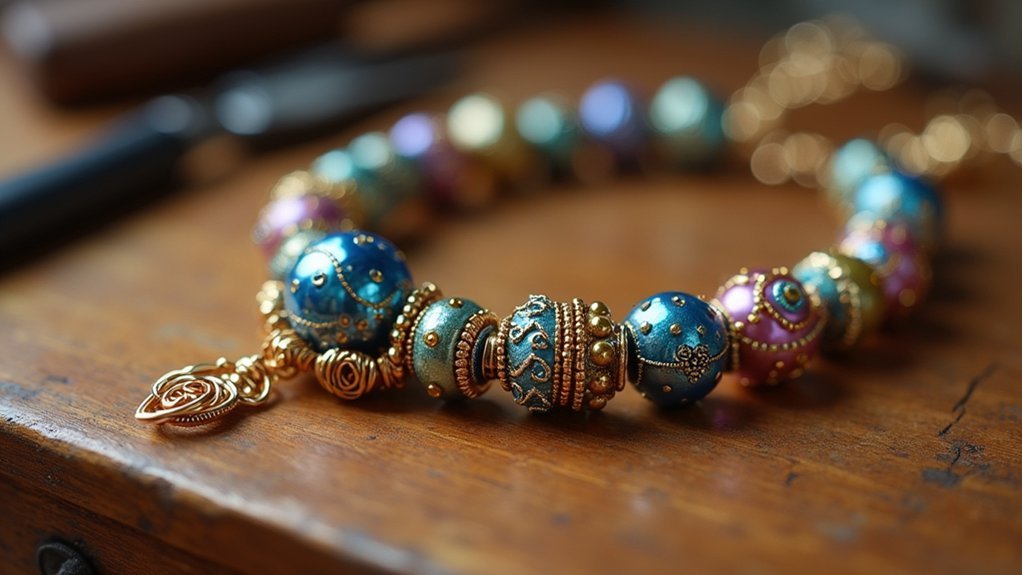
Begin by securing your workspace with proper lighting and organizing your materials—dark turquoise, light turquoise, carnelian, and gold spacer beads alongside your eyepins, pliers, and nippers. You’ll use eyepins to thread beads in the recommended order for authentic Egyptian styling.
| Step | Technique | Tool Required | Tip |
|---|---|---|---|
| 1 | Create secure loops | Pliers | Close tightly at both ends |
| 2 | Thread bead sequence | Eyepins | Follow traditional color order |
| 3 | Assembly line method | Nippers | Complete multiple pieces efficiently |
| 4 | Take regular breaks | None | Prevent fatigue-related mistakes |
| 5 | Final adjustments | Pliers | Guarantee polished finish |
Master these threading techniques by working systematically through each eyepin, maintaining consistent tension while securing loops to prevent beads from slipping off during assembly.
Memory Wire Stringing and Pattern Assembly
Memory wire offers unparalleled flexibility for creating authentic Egyptian collars, as its natural coiling properties eliminate the need for traditional clasps while maintaining the piece’s distinctive circular shape.
Memory wire’s inherent coiling nature creates perfectly shaped Egyptian collars without clasps, delivering both authenticity and effortless wearability for historical jewelry artisans.
You’ll need to cut the memory wire to appropriate length, allowing multiple rounds while ensuring secure looped ends prevent bead slippage.
Begin stringing beads following your predetermined pattern, carefully arranging verticals and spacers to achieve your desired aesthetic. Use memory wire cutters specifically designed for this material—regular cutters can damage the wire and compromise integrity.
Consider implementing an assembly line method during stringing to enhance efficiency. Take breaks as needed to maintain focus and prevent fatigue.
After threading all beads, tightly loop the wire’s end to secure your arrangement, ensuring the closure mechanism provides comfortable wear.
Creating Secure Closures and Fastening Methods
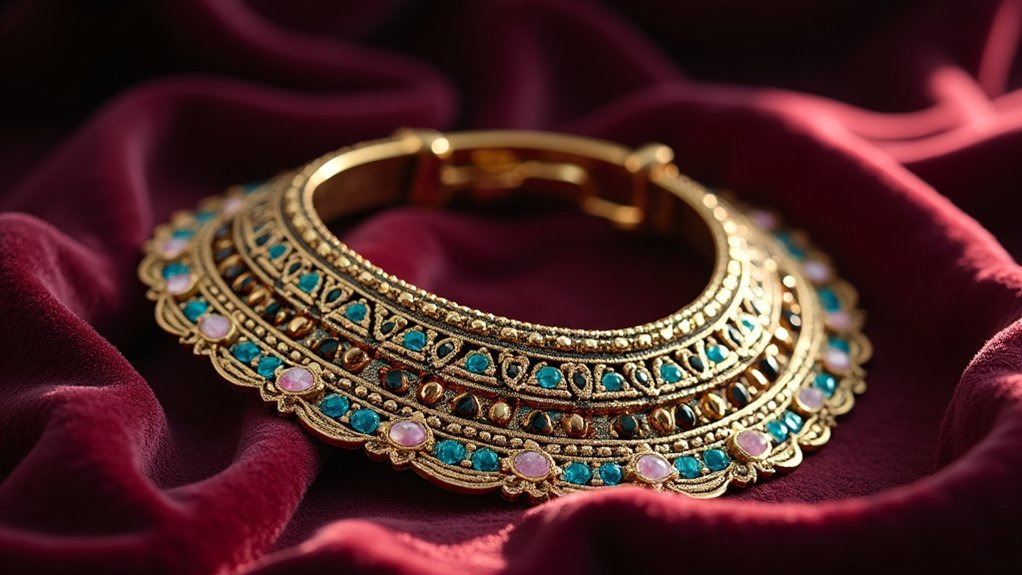
When your Egyptian collar nearing completion, you’ll face the critical decision of selecting an appropriate closure method that balances security, comfort, and historical authenticity. Your choice directly impacts both the piece’s functionality and aesthetic appeal.
Consider these three effective fastening approaches:
- Custom wire clasps – Shape these to match your design while guaranteeing durable connections that withstand regular wear.
- Raw silk ties – Offer cultural accuracy and comfort for sensitive skin while maintaining strength.
- Quality materials integration – Use gold or sturdy metals that complement your collar’s overall aesthetic.
Test your closures by applying gentle force to confirm durability.
Include adjustable elements to accommodate various neck sizes, enhancing wearability.
These considerations guarantee your Egyptian collar remains both beautiful and functional.
Color Symbolism and Cultural Accuracy in Design
You’ll need to understand the profound meanings behind ancient Egyptian colors to create culturally accurate collar designs that honor this rich heritage.
Green represented fertility and growth, black symbolized the life-giving Nile silt, and blue connected pieces to divine domains through precious lapis lazuli.
Your gemstone and material choices must reflect these sacred associations while balancing authentic color symbolism with practical design considerations for modern wearers.
Ancient Egyptian Color Meanings
Although modern jewelers often focus primarily on aesthetic appeal, understanding ancient Egyptian color symbolism will elevate your collar designs from mere decoration to culturally authentic masterpieces.
When creating ancient jewelry inspired by New Kingdom traditions, you’ll need to grasp the profound meanings behind each hue.
Each color carried specific significance in Egyptian culture:
- Green and Blue – Green symbolized fertility and abundance, while blue (often lapis lazuli) represented divine heavens and gods.
- Black and White – Black denoted the Nile’s rich agricultural silt, and white signified purity and sacred power.
- Silver Accents – Connected wearers to celestial forces, representing moon and stars.
Glass beads revolutionized color symbolism by expanding beyond natural gemstone limitations.
Your collar creations should honor these meanings rather than simply copying visual elements.
Sacred Symbolism in Gemstones
Beyond understanding color meanings, you must recognize that specific gemstones carried their own sacred powers in ancient Egyptian belief systems. The sacred symbolism embedded within these materials transcended mere decoration, serving as protective talismans and divine connections.
Lapis lazuli held paramount importance among ancient Egyptians, representing the heavens through its deep blue hue. You’ll find this gemstone frequently adorning pharaohs and deities in tomb paintings.
Green stones like malachite embodied fertility and rebirth, while black obsidian connected to the life-giving Nile silt.
When creating Egyptian collars, you can’t ignore this profound color symbolism. Each gemstone selection must reflect authentic spiritual beliefs.
Silver elements should mirror celestial themes, while white stones maintain purity symbolism. This understanding transforms your jewelry from simple ornamentation into meaningful cultural artifacts.
Authentic Material Selection Guidelines
When creating authentic Egyptian collars, your material choices must align with both historical accuracy and sacred symbolism to honor the profound cultural significance of these ancient artifacts.
Following proper authentic material selection guidelines guarantees you’ll capture the essence of ancient craftsmanship while respecting cultural traditions.
Your primary materials should include:
- Premium gemstones like turquoise and carnelian, which held deep symbolic meaning and were prized for their natural beauty and spiritual significance.
- Faience beads to replicate vibrant colors affordably while mimicking expensive gems through this early ceramic technique.
- Gold components reserved historically for nobility, conveying status and authenticity in your design.
Remember that color symbolism drives material selection—green represents fertility and life, while blue signifies heavenly domains.
Incorporate traditional motifs including protective amulets and animal shapes to enhance cultural accuracy.
Final Assembly and Quality Control Checks
As you approach the final assembly stage of your Egyptian collar, you’ll need to cut a longer piece of memory wire that accommodates the entire design while allowing for proper loop formation.
Create a secure loop at one end before threading your beads in the specified sequence. Keep threading tight and guarantee both wire ends are properly looped to maintain structural integrity.
Implement thorough quality control by inspecting each bead for defects and confirming all loops are securely attached to prevent breakage.
When crafting closures, choose custom wire clasps or raw silk ties that complement your design aesthetically while remaining functional.
Complete your final assembly with a detailed check, ensuring all components are securely attached and the collar fits comfortably with proper adjustability for the wearer.
Frequently Asked Questions
How to Make an Egyptian Collar?
You’ll cut memory wire to desired length, thread prepared beads using eyepins in Egyptian patterns, create secure loops at both ends, and attach custom clasps or silk ties for closure.
What Is the Technique of Making Egyptian Jewelry?
You’ll use gold, copper, and gemstones for authentic Egyptian jewelry. Master bow drilling for precise beads, work with faience to mimic expensive stones, and integrate protective amulets into your designs using traditional beadwork techniques.
How Were Egyptian Collars Made?
You’d thread beads onto eyepins in specific patterns, then string them on memory wire for multiple rounds. You’d secure loops at both ends and add closures like wire clasps or silk ties.
What Is Most Famous Piece of Egyptian Jewelry?
You’ll find Tutankhamun’s gold funerary mask is the most famous Egyptian jewelry piece. It’s crafted from solid gold and inlaid with lapis lazuli, turquoise, and carnelian, representing ancient Egypt’s exceptional artistry.
In Summary
You’ve now mastered the essential techniques for crafting authentic Egyptian collars. Remember, you’ll achieve the best results when you combine traditional materials with precise wire work and culturally accurate color schemes. Don’t rush your final assembly – take time to inspect each connection and make certain your closures are secure. With practice, you’ll create stunning pieces that honor ancient Egyptian artistry while meeting modern jewelry standards.

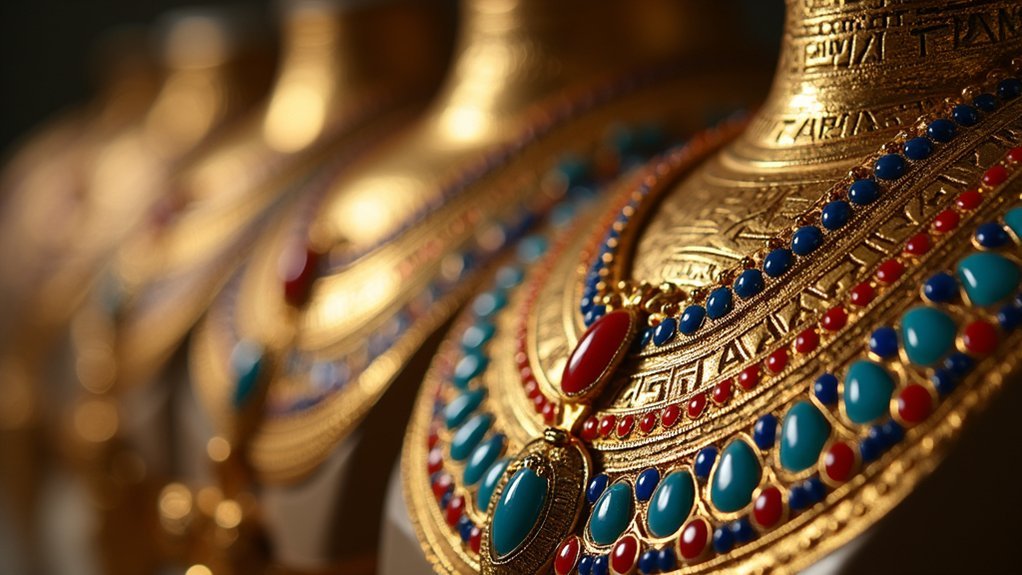

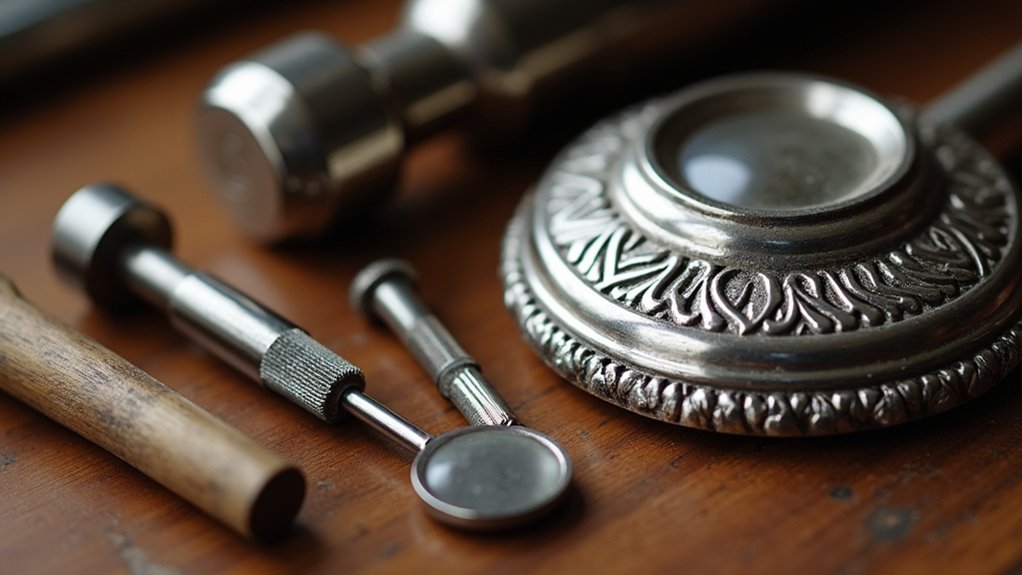
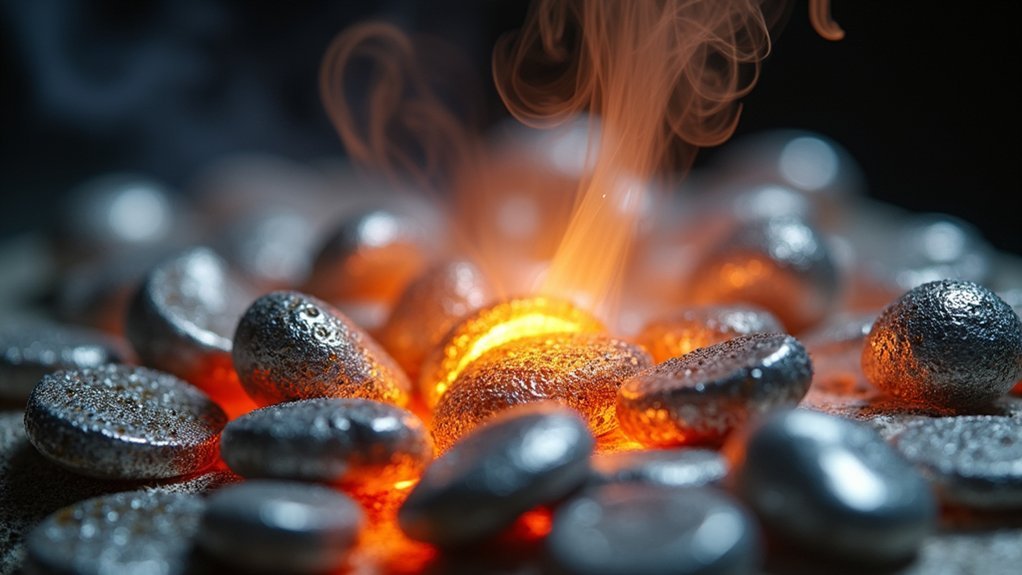
Leave a Reply